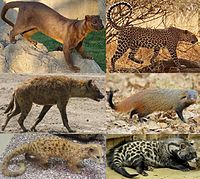Feliformia
| Feliforms Temporal range: Eocene-Holocene |
|
|---|---|
 |
|
| Several extant feliform families: Eupleridae, Felidae, Hyaenidae, Herpestidae, Nandiniidae and Viverridae. | |
| Scientific classification | |
| Kingdom: | Animalia |
| Phylum: | Chordata |
| Class: | Mammalia |
| Order: | Carnivora |
| Suborder: |
Feliformia Kretzoi, 1945 |
| Families | |
Feliformia (also Feloidea) is the name of a suborder within the order Carnivora consisting of "cat-like" carnivorans, including cats (large and small), hyenas, mongooses, civets, and related taxa. Feliformia stands in contrast to the other suborder of Carnivora, Caniformia ("dog-like" carnivorans).
The separation of the Carnivora into the broad groups of feliforms and caniforms is widely accepted, as is the definition of Feliformia and Caniformia as suborders (sometimes superfamilies). The classification of feliforms as part of the Feliformia suborder or under separate groupings continues to evolve.
Systematic classifications dealing with only extant taxa include all feliforms into the Feliformia suborder, though variations exist in the definition and grouping of families and genera. Indeed, molecular phylogenies suggest that all extant Feliformia are monophyletic.
The extant families as reflected in the taxa chart at right and the discussions in this article reflect the most contemporary and well-supported views (as at the time of writing this article).
Systematic classifications dealing with both extant and extinct taxa vary more widely. Some separate the feliforms (extant and extinct) as: Aeluroidea (superfamily) and Feliformia (suborder). Others include all feliforms (extant, extinct and "possible ancestors") into the Feliformia suborder. Recent studies suggest this inclusion of "possible ancestors" into Feliformia (or even Carnivora) may be spurious. The extinct (†) families as reflected in the taxa chart are the least problematic in terms of their relationship with extant feliforms (with the most problematic being Nimravidae).
All extant feliforms share a common attribute: their auditory bullae (bony capsules enclosing the middle and inner ear). This is a key diagnostic in classifying species as feliform versus caniform. In feliforms, the auditory bullae are double-chambered, composed of two bones joined by a septum. Caniforms have single-chambered or partially divided auditory bullae, composed of a single bone. This feature, however, is problematic for the classification of the extinct Nimravidae as feliforms. Nimravid fossils show ossified bullae with no septum, or no trace at all of the entire bulla. It is assumed that they had a cartilaginous housing of the ear mechanism.
...
Wikipedia
